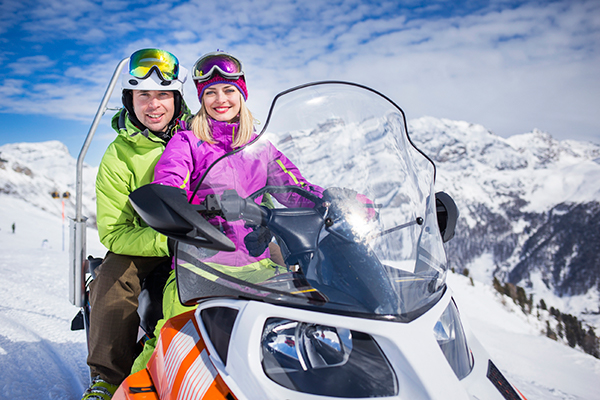Snowmobiling can be fun and exhilarating but equally dangerous if you don’t follow some safety precautions. If you’re a newbie to snowmobiling, it’s highly advised to stick to driving on flat well-groomed trails until you become more experienced. Riding off-trail in ungroomed terrain should only be done when you’re more advanced in your skills and ability to control your machine.
A good rule of thumb is to make sure your snowmobile is licensed and registered. Not all trail-grounds require you to register your snowmobile, so check the location you are visiting. In many states it’s not required, but it’s also advised that first-time riders take a safety class. You’ll also want to make sure you have the proper insurance on your pricey toy. In the event you mishandle your snowmobile, you don’t want to spend even more money to get back out on the trail. To shop around for multiple insurance rate quotes from several carriers, click here.
Starting Your Machine
- Make sure you’re on flat terrain.
- Point your vehicle in a safe direction.
- Put the vehicle into neutral position. Grip the handlebar with one hand as you start with the other. Close the choke. You will either have an electric or cord start, so either push or pull, depending on your starter. You don’t want to just get on your snowmobile, turn it on and take off. It’s best to idle to allow your vehicle to warm up.
- If the engine doesn’t start, try it again. If it’s still not starting, you may have to play with the throttle a bit to get it to start. However, be careful to not flood the engine. If you’re using the choke and it doesn’t start right away, stop (without using more gas) and give it a minute or two before trying again.
- When the engine does start, open the choke slowly and give it some throttle until you feel it’s idling properly.
- Give it at least five minutes, but no more than 10 minutes is generally needed for warming up.
Controlling Your Snowmobile
- You’re going to want to learn how to maintain control on the trails. Always sit with your feet on the running boards and have both hands on the handlebars and throttle.
- Keep your weight centered and low as you hit the throttle and go forward. Start slowly and follow the track. It’s okay to go a little faster where the track goes straight but for your first few sessions, just focus on getting the feel of your snowmobile without speeding.
- When you do approach curves, lean into it with your weight completely shifted over the snowmobile. During your first few attempts at a curve, you may slide off the trail and end up in powder. Hit the throttle hard if that happens. Keep throttling until you return to the paved track. If you don’t use your throttle, your machine will sink under the weight of snow.
- Whenever you ride your machine through powder, you’ll need to have your throttle on high to push through. You’ll also need to maneuver your snowmobile much more rigorously than on paved tracks. For instance, if your machine begins to veer left, you’ll have to put all your weight right and over the edge of your snowmobile to guide it back. You will often use your own weight to steer the snowmobile when riding through powder. That is why it’s highly recommended that you first become skilled on groomed terrain. In order to maneuver through snow, you’ll need to have upper-body strength.
- While there are several snowmobile riding positions, sitting is always safest.
What about the Snowy Hills?
- Yes, the hills look pretty exciting, don’t they? Well, the truth is that they can be pretty dangerous too. Whenever you take your snowmobile on an incline there’s a chance of the rolling the machine and getting hurt or damaging your snowmobile. Don’t assume that snow will somehow protect you from impact, either. You can get really hurt, even fatally, if you lose control of your vehicle.
- If you ride your snowmobile uphill, you are increasing your risk of rolling. But if you have no choice but to go uphill, one knee should be on the seat while one foot is on the side rail. Lean forward and put pressure on the handles.
- Standing and leaning forward can also be useful if you’re going up steep hills and are having trouble. However, it’s important to be very careful when standing, which you really only want to do on steep inclines and when visibility is a problem when seated.
- When going downhill, put your feet on the running boards and lean back. When riding over a side-hill, lean hard towards the incline of the hill while resting your knee and shin on the side rail.
Hand Signals
If you are snowmobiling in an area where the trails are packed with people, it’s always good to know hand signals. The Snowmobile Safety Awareness Program has created a visual list of the different hand signals and when to use them. It’s good to communicate with others to prevent an accident, so you should know the language before you get on your snowmobile.
Be safe, don’t take risks, make sure you’re insured and have fun!
The information in this article was obtained from various sources. This content is offered for educational purposes only and does not represent contractual agreements, nor is it intended to replace manuals or instructions provided by the manufacturer or the advice of a qualified professional. The definitions, terms and coverage in a given policy may be different than those suggested here and such policy will be governed by the language contained therein. No warranty or appropriateness for a specific purpose is expressed or implied.
